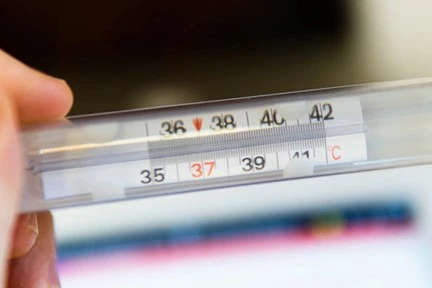One of the first signs of getting sick is a fever. You feel hot or "flushed" as your grandmother used to say, your joints may ache, and you might feel sweaty or chilled. Today everyone is checking their temperature since fever is an early sign of COVID-19. But how high does your temperature have to be before it's considered a fever?
What is a Fever?
Despite what kitchen cleaner ads tell us, viruses and bacteria are not very strong. They can be killed by high temperatures. When you have a fever, it's your body's way of fighting off infection by getting too hot for the virus or bacteria to survive. If you've had an infected cut, and noticed the area was warm, that's a localized fever, busy killing bacteria around the cut.
Normal Body Temperature
The normal body temperature range is between 97.5-99.6 degrees Fahrenheit. It used to be thought the "normal" was 98.6 F, but studies have shown the average is a bit lower. As with anything else, the best thing to do is know what your usual temperature is and work from that.
You should know what your normal body temperature is because a few degrees difference can be important when discussing fever. For instance, if your temperature is normally 97 degrees, you might have a fever if your temperature is a "normal" 98.6. On the other hand, if your regular temperature is 99 degrees, you would not have a fever if your temperature was 99.1 degrees.
Levels of Fevers
Your body temperature fluctuates depending on the weather and time of day, and factors like gender, weight, and exercise. If you've been working out in the middle of a hot day, your temperature is probably higher than usual. Fever is a body process that raises your core temperature and keeps it up until the infection is gone.
Fevers are categorized by the grade or range of temperature.
Infants | Children | Adults | |
Low-Grade | 99.0-100.3 degrees F | 99.6-100.3 degrees F | 99.7-100.9 degrees F. |
Moderate-Grade | 100.4-102.6 degrees F | 100.4-102.9 degrees F | 100.9-104.0 degrees F. |
High-Grade | >102.6 degrees F. | >102.9 degrees F | >104.1degrees F. |
Fevers can also be classified by how long they last. Acute fevers last fewer than seven days; chronic fevers last more than 14 days. Some diseases have periodic or "intermittent" fevers that come and go during a 24-hour period.
A temperature above 106.7 degrees F is called hyperpyrexia. This extremely serious condition is often seen in heat stroke and means the body's cooling system has collapsed. Hyperpyrexia can lead to permanent brain damage, kidney failure, and even death if not treated immediately.
Treating Simple Fevers
Most fevers don't require medical intervention. Your pharmacist can give you over-the-counter medication to reduce fever, ease the pain, and get back to feeling better. If you have a fever, the pharmacy should be your first stop for medications and other remedies, since your doctor can't do much for a cold or flu. If you have something more serious and are prescribed medications such as an antibiotic or fever-reducer, you can your RxLess discount card to save at the pharmacy.

















